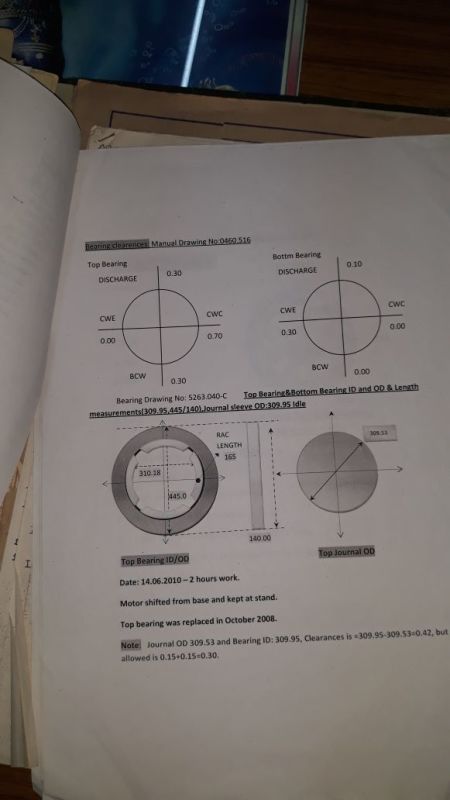It sounds like the motor has already moved on, so no more need for input. But nevertheless I finally got around to googling to see what I could find just for general info and my own learning.
Here is an article from Chuck Yung of EASA, who’s generally a good resource on motor repair.
Figure 1 applies to horizontal machines, but let’s start there.
For your size shaft (in this case runner) diameter is 0.3m ~ 12”. The lowest number we might read off the chart is 0.013” diameteral (0.0065” per side) on curve I. Close examination of the curve I reveals it matches the one of the thumbrules mentioned in the article: “One thousandth, plus 1 per in. of diameter”
You ended up a little lower than 0.0065” per side at 0.1mm = 0.004” (I assume your 0.1mm was per side). As they go on to say the vertical machine clearance is smaller than for horizontal machines, so no problem there.
Now what do they say about the difference for vertical machines:
Vertical machines: Why are they different?
To begin with, on a vertical machine the same spindly shaft and heavy rotor does not cause shaft deflection as it would on a horizontal machine. While the shaft rests on the bottom of a horizontal bearing, it hangs more-or-less centered in the vertical thrust bearing, so there’s no radial sag to worry about.
In addition, guide bearings for vertical sleeve bearing machines are not the cylindrical overshot design, so they require much less clearance than bearings on horizontal machines with similar journal diameters. As long as there is sufficient radial clearance for the oil film, the vertical guide bearing needs no additional clearance. Contact the OEM or your service center for guidance.
I try to parse that quote above for my own benefit…
First paragraph, we don’t have as much of a tilted rotor in vicinity of the bearing, so I guess that allows us to use smaller clearances without creating a moment on the bearing.
Second paragraph first sentence talks about “overshot” design. I had to go back earlier to figure out what that term overshot means. In the text it suggests a bearing style that uses oil ring lubrication (and so has a cutout for the ring in upper half of bearing along with distribution grooves). In the figure they show something resembling really large distribution grooves. I guess the distribution grooves is what they’re talking about with overshot design. How does that play in? I’m not sure… I guess it maybe (?) means that (compared to some vertical designs) there is better oil flow fed into the bearing clearance and therefore better heat removal when distribution grooves are present.
Second paragraph 2nd sentence seems strange to me: “As long as there is sufficient radial clearance for the oil film, the vertical guide bearing needs no additional clearance.”. Well what clearance does an oil film need… I am used to thinking maybe 0.001” or less in the smallest clearance location of a loaded bearing. But of course if we put 0.001” per side as a uniform clearance all the way around, then the bearing is effectively loaded all the way around and generates a lot of heat. So I think maybe he is simply saying that the minimum clearance is governed by thermal considerations. I.E. the bearing clearance needs to be large enough to prevent hot bearing.
=== ==== ===
The article says viscosity is not a big factor, but I think it will be a bigger factor for vertical guide bearings than horizontal radial bearings because we have a lot bigger variation in viscosity on vertical machines than horizontal machines. Our horizontal machines all VG32 or VG68. Our vertical machines we have range from VG32 to VG150 on our low-speed CW pumps. The higher viscosity grade is due to the slow speed and also the heavy load on the thrust bearing (guide bearing shares the same oil)
The EASA article didn’t really talk about downsides of too large a bearing clearance in vertical machine radial bearing, but I think that is generally on the vibration side… excess vibration due to either orbitting at 1x in a big clearance or else subsynchronous oil whirl which I think is more likely when vertical machine bearing clearances are large. (On the vibration side we also know of couse any change in clearance in either direction affects the effective stiffness and can tune rotor resonance, but in most situations that aspect is not practical to analyse).
So my bottom line is: too small makes the radial bearing run hot and too large makes more likely vibration problems. (after all that hot air, that’s probably no surprise to anyone). The best bet is of course to compare to proven-design machines that are somewhat similar, which I’m sure was part of your thought process.
=====================================
(2B)+(2B)' ?

